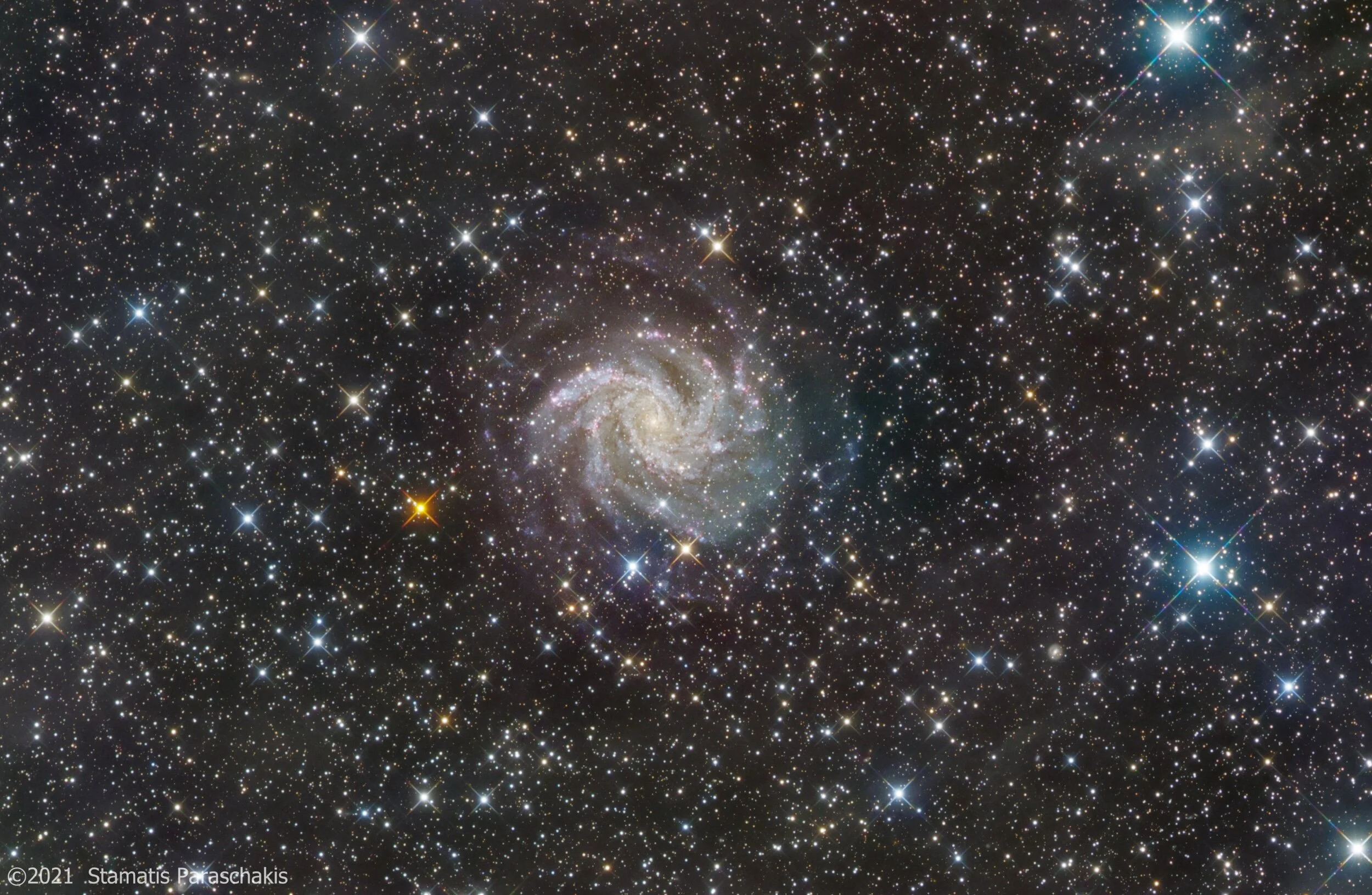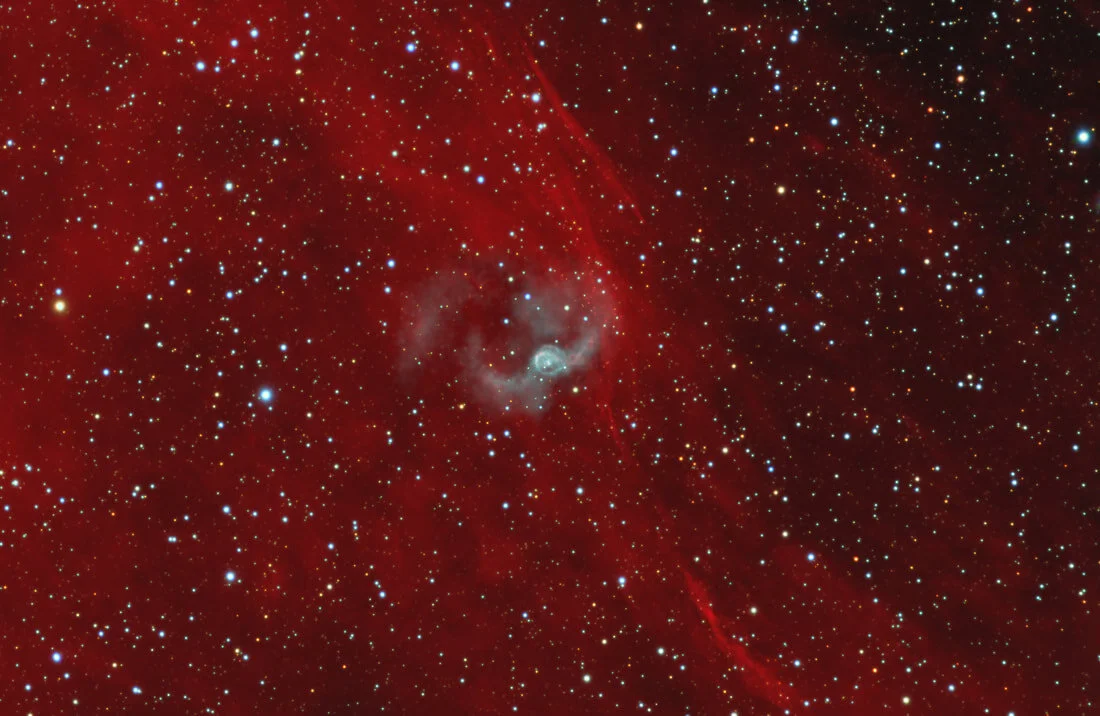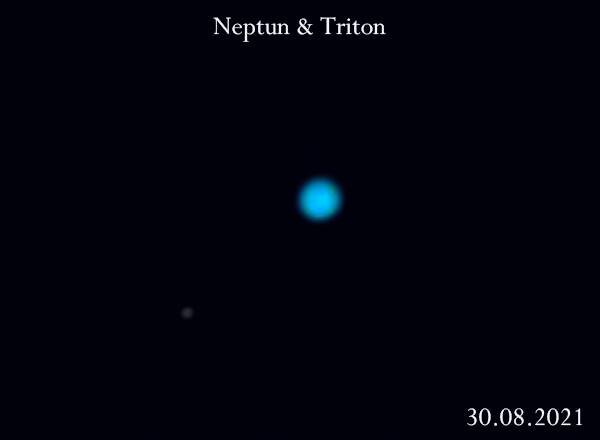
AAPOD2 Image Archives
Floating beauty
Image Description:
27-8-2021 Moon age: 18.8 days Moon phase: Waning Gibbous LEB - Bortle 7 class -Rig Details: Celestron EdgeHD 9.25 on CGX Baader UV/IR cut filter ZWO asi224mc TV 2.5x powermate SharpCap
Copyright: Omar S. Rajji
IC 1340 - THE BAT NEBULA
Image Description and Details : IC 1340, otherwise known as The Bat Nebula and Caldwell 33, is a beautiful portion of the Cygnus loop supernova remnant that reveals delicate wisps and filaments of nebulosity. Sadly, it is often overlooked because of the notoriety of three other portions of the Cygnus loop, namely the Veil Nebula, The Witch's Broom Nebula, and Pickering's Triangle. IC 1340 is the continuation of the Veil Nebula. The nebula lies approximately 1,500 light-years from Earth.
Imaging telescopes or lenses: GSO RC 8'' F/8 Carbon Fiber @ 1120mm
Imaging cameras: QHYCCD QHY 183M
Mounts: iOptron Cem70 and Sky-Watcher EQ6 Rowan belt mod
Guiding telescopes: GSO RC 8'' F/8 Carbon Fiber @ 1120mm
Guiding cameras: Imaging source dmk21au618
Focal reducers: astrophisics 0.67x
Software: Pleadies astro Pixinsight 1.8.8, KStars INDI/Ekos
Filters: Optolong Ha 7nm, IDAS LP2 v2, Optolong OIII 6.5nm 31mm, Baader LRGB 31mm
Accessory: QHY-CCD CFW2-7 31mm
Multiple exposure time has been used to obtain the best of details, for a total exposure time of about 59 hours.
HAlpha 222x600" -20C bin 1x1
Oiii 114x600" -20C bin 1x1
RGB: 36x300" -20C bin 1x1 / 12 subs for each filter
Copyright Information: Acquisition by Giuseppe Amante & Alessandro Pensato.
Pixinsight processing by Giuseppe Amante
NGC 6946
Image Description and Details : Imaging telescope: LACERTA 200/800 Carbon FotoNewton Edition 2021
Imaging camera: QHYCCD QHY183M
Mount: SkyWatcher EQ6-R Pro
Guiding telescope: QHYOAG-LACERTA 200/800 Carbon FotoNewton Edition 2021
Guiding camera: ZWO 290MM Mini
Coma corrector: GPU Optics GPU Komakorrektor
Baader Planetarium B 1.25" CCD Filter: 50x210" (2h 55') (gain: 11.00) -15C bin 1x1
Baader Planetarium G 1.25" CCD Filter: 50x210" (2h 55') (gain: 11.00) -15C bin 1x1
Baader Planetarium Luminance 1.25": 400x90" (10h) (gain: 11.00) -15C bin 1x1
Baader Planetarium R 1.25" CCD Filter: 50x210" (2h 55') (gain: 11.00) -15C bin 1x1
Integration: 18h 45'
RA center: 20h 34' 41"
DEC center: +60° 8' 13"
Pixel scale: 0.620 arcsec/pixel
Orientation: 358.766 degrees
Field radius: 0.552 degrees
Location: Kalliopi, Lemnos, Greece
Copyright: ©2021 Stamatis Paraschakis
PM1-320
PM1-320 is a small planetary nebula in Cygnus, close to DWB 111, the Propeller Nebula.
It was discovered by Andrea Preite-Martinez in the 1980s.
I believe this to be the first deep high-resolution image of PM1-320.
The outer parts of the nebulosity are very faint, hence 56 hours of OIII integration.
HASH records it's size as 60 arc seconds.
TARGET
Nomenclature: PM1-320
Right Ascension: 20:10:33.6
Declination: +44:11:48.48
Size: 60.0 arc sec
Discovery: Andrea Preite-Martinez
EQUIPMENT USED
Twin APM TMB LZOS 152 refractors
10Micron GM2000 HPS mount
Twin QSI6120 CCD cameras
Astrodon filters
IMAGE CAPTURE
Blue: 10x300"
Green: 10x300"
Lum: 15x300"
Red: 10x300"
Ha: 103x900" bin 1x1
OIII: 226x900 bn 1x1
Total Integration: 86 hours
Pixel scale: 0.265 arcsec/pixel
Field radius: 0.368 degrees
Capture dates: 20 August-3 September 2021
Capture location: Fregenal de la Sierra, Spain
IMAGE PROCESSING
Pre-processing: CCDStack2
Post-processing: Photoshop CS2
Copyright: Peter Goodhew
Neptune and Triton
Observations 30.08.2021 .The farthest planet from Earth Planet NEPTUNE (mag. +7.8, diam. 2.4 ") with Triton satellite (mag. +13.45 diam. 0.13"), capture by Omegon 304/1200 Barlow 5X Televue telescope, Zwo Asi 224 camera. Stak from 2000 framesThe planet is visible through a telescope in the constellation Aquarius, on September 16, 2021 being in opposition, the distance from Earth 4.3 billion km.30.08.2021 at 23:50
Copyright: Balint-Forro Eugen
Rupes Recta - Prominent linear fault on the Moon and volcanic rille
Image Description and Details :
Rupes Recta is a linear fault on the Moon, in the southeastern part of the Mare Nubium. The name is Latin for straight cliff, although it is more commonly called the Straight Wall. This is the most well-known escarpment on the Moon, and is a popular target for amateur astronomers.
When the sun illuminates the feature at an oblique angle at about day 8 of the Moon's orbit, the Rupes Recta casts a wide shadow that gives it the appearance of a steep cliff. The fault has a length of 110 km, a typical width of 2–3 km, and a height of 240–300 m. Thus although it appears to be a vertical cliff in the lunar surface, in actuality the grade of the slope is relatively shallow.
To the west of this escarpment is the crater Birt, which is about 17 km in diameter. The Birt Rille is a slightly curved ~50 km long channel that starts and ends in a pit.
Telescope: Clestron 9.25 f/10
Reducer/corrector: No reducer
Filter: Baader UV-IR cut
Mount: Orion Atlas EQG
Camera: DMK 23U618
Exposure: 2000 frames @ 60fps x 2 images mosaic
Procesing: Autostakkert + Registax + PixInsight
Copyright: Astronomica.es - Jaime Fernández
Sharpless -155 “Cave Nebula”
The Cave Nebula (Sh2- 155 or Caldwell 9) is an emission nebula of the Cepheus constellation.
It is a weak light nebula and very diffuse in a greater complex of nebula containing dark emission, reflection and nebulosity. It is located in the constellation of Cepheus and is about 2400 light years from Earth.
Acquisitions with NINA
344 x 300 s i.e. 28 H40
ASKAR 400 bezel
ASI200MC
SIRIL stacking
Pixinsight and Photoshop treatment
Copyright Fred Lamagat
NGC 6914 AND LDN 899
NGC 6914 is a nebula complex composed of emission and reflection nebula. It is located approximately 6 light-years from Earth in the Swan constellation.
You can also see two pretty little blue nebula.
Material:
- TS 107/00
- Rising clone 2600mc
- AZEQ time
Acquisition:
50 X300s to-15
Copyright: Emmanuel Tesnieres
Sharpless 132 - The Lion Nebula
Sharpless 132 is a very faint emission type nebula on the Cepheus/Lacerta border. It lies at a degree southeast of Epsilon Cep, and has a size of about 40 arc minutes.
Sh2-132 is located at about 10400 light years in the Perseus Arm of the Milky Way , in the region of Cepheus OB1, a large, bright OB association . The stars responsible for the ionization of its gases are very hot and massive; in particular, two Wolf-Rayet stars , known by the initials HD and HD 211 564 211 853 (the latter also having the initials WR 153), as well as a star of spectral class O8.5V and a dozen stars of class B.
Equipment used:
Eq6-R
AstroTech 106LE with upgraded Moonlite focuser
TSFlat 2" field flattener
ASI294MM Pro Cmos camera, cooled at - 15°C
8x1.25" ZWO USB filterwheel
Chroma 3nm 1.25" Ha, Oiii ans Sii filters
Qhyccd QHY5L-IIM guide camera
9x50mm finder-guider
Qhyccd Polemaster
Software used:
Eqmod, SGP - Sequence Generator Pro, PHD2, Stellarium with stellariumScope, SharpCap for polar alignment
Date: 01.06 to 15.07.2021
Location: Bushey, bortle 7
Ha: 80x300sec Bin 2x2, Gain 200 Offset 10
Oiii: 60x300sec Bin 2x2, Gain 200 Offset 10
Sii: 50x300sec Bin 2x2, Gain 200 Offset 10
Total integration time 15 hours and 50 minutes
Stacked in AstroPixel Processor and processed in Pixinsight and Photoshop CC 2021
Copyright: Emil Andronic










